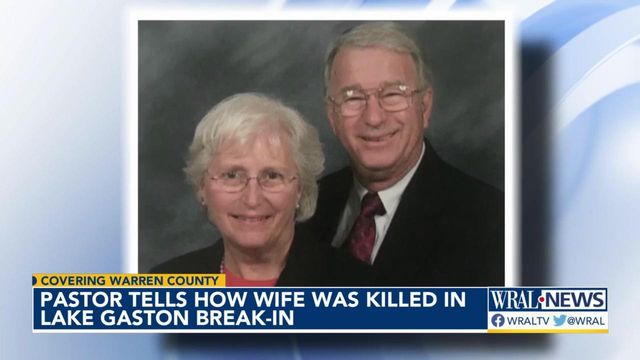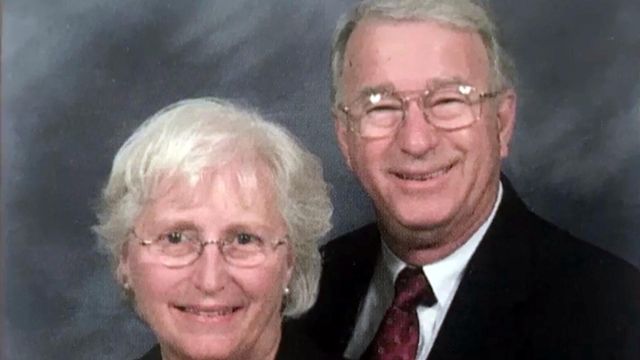Defense questions Lake Gaston man's ability to identify suspect charged in his wife's 2018 murder
The murder trial that began on Tuesday hinges on John Alford's ability to identify the man he said held a knife to his throat and tied him up before burning down his house with his wife inside. While on the stand, the defense attempted to sow doubt about the legitimacy of Alford's identification of Lester Kearney, 36, who has maintained his innocence in the crime.
Posted — UpdatedThe murder trial that began on Tuesday hinges on Alford's ability to identify the man he said held a knife to his throat and tied him up before burning down his house with his wife inside. While on the stand, the defense attempted to sow doubt about the legitimacy of Alford's identification of Lester Kearney, 36, who has maintained his innocence in the crime.
It's unclear at this time if Munn will testify in court, and if he does take the stand, if he will cooperate with the prosecution.
Without Munn's testimony, the only evidence linking Kearney to the crime is Alford's witness testimony.
Defense attorneys claim Alford only identified Kearney after seeing his mugshot during a police press conference on the news.
"When I saw the picture on the TV, that was the first time I saw anything on the TV in the burn unit," Alford said in court. "I do recall saying, 'That's the man,' when I pointed to that picture."
Alford claims that he was basing that positive identification on his memory, not based off what he saw on the TV.
"Rev. Alford, if you were not sure that Lester Kearney was the man standing in your bedroom, would you speak up now and say that?" one of the prosecutors asked Alford.
"Absolutely," he replied.
When questioned by the defense, Alford admitted that he understood at the time that Kearney's mugshot was on the news because he had been arrested in connection to his wife's murder. Alford said that he wasn't completely aware that what he was watching on the news was a press conference.
Alford said that an agent with the State Bureau of Investigation (SBI) met him in UNC Health's burn unit and brought him Kearney's mugshot. Alford told the agent Kearney was the man who tied him up and held a knife to his neck.
Mallory Bennet, a former SBI agent who testified on Wednesday, said Alford told her that the man who attacked him had on a hat black paint to disguise himself. An initial police report indicated that the two men were also wearing skii masks, but Alford did not mention that in his testimony on Wednesday.
Despite the fact that prosecutors say Alford told investigators that he could pick Kearney out of a photo line up, Alford was never asked to pick Kearney's mugshot out from a group of photos.
"Those first days were really, really bad, with respect to the burns," Alford said, emphasizing he was not entirely coherent during that time. During opening statements, the defense pointed to Alford's age, 84, and the fact that he was heavily medicated as reason to why his positive identification of Kearney is invalid.
Bennet said that Alford told her he knew Munn before the murder. Munn worked for a carpenter, Tommy Overby, who frequently did work for the Alfords. Before Nancy Alford's murder, Overby had his home broken into multiple times, according to Kearney's attorney.
Alford describes home invasion: 'I was convinced I was going to die'
Alford said he and Nancy Alford were sleeping in bed together the morning of the crime.
Alford said they returned home in the afternoon, ate dinner together and watched Netflix. They went to bed at 10:30 p.m.
While they were sleeping the next morning, he said they heard a crashing sound hit the end of their house, which startled them both wide awake. Alford recalled, “My wife looked at me and said, ‘What in the world is that?’”
He said his wife asked him to find the source of the noise. When he pulled back the covers, he said he saw a man in his bedroom “standing right there in front of me.”
When he tried to stand up, Alford said the man hit him with his hand “very hard” directly into his face. Alford fell back into the bed and the man hit him again several times, he said. Alford was bleeding from his mouth.
Alford said his wife yelled at the man, “Please stop hitting my husband, he is 80 years old.”
The man said he had a knife and would cut Alford if he tried to escape, he recalled.
At that point Alford said the man began to tie him to the bed. Alford said he was left there, lying under the covers, while the man talked to his wife. Alford said the man told him another man was on the way to their home with a gun.
“At that moment I was convinced I was going to die in my own bed,” he said.
Alford believes the man drove his wife to their bank, located about 25 miles from their home, so she could give him money.
Alford said his mouth was in “horrible shape” but he eventually used his teeth to gnaw the rope off his hands. He stayed in bed and remained silent, worried another person may be in the house. He said kept the covers over his head.
After more than an hour had passed, he said he heard his wife and the man return. He heard his wife cry out from another room, and he heard her body slam into the floor.
He said he tried to save her, saying in court Wednesday he thought, “If I’m going to die, I’m going to die trying to help my wife.”
When Alford got out of the bed, he said a “wall of fire” came roaring into his bedroom.
He couldn’t get out of the bedroom without walking directly into the fire, so he opened the French doors opening out to the deck from his bedroom. Alford walked around the outside of his house to enter the front of the home from the outside.
He said he laid down on his stomach and crawled on the floor, underneath the thick black smoke, looking for his wife and calling out. He never got a response.
Finally, the heat and smoke became so intense that Alford backed out the front door.
Family, advocates say authorities have treated Kearney unfairly due to his race
James Kearney, a former sheriff's sergeant and Lester Kearney's uncle, voiced his compassion for the victims but said Black men like Lester have struggled for years.
"I've been pulled over for no reason," he said. "North Carolina has to come out of their old ways ... [it's] very racist. I am sorry I have to say it like that, but that's how it is."
Attorney Dawn Blagrove, head of Emancipate NC, concluded the conference by asking for a fair trial.
"We want equity. We want fairness. We want objectivity," she said. "We do not want to rush to judgment for Lester and we do not do not in any way want to interject ourselves or our thoughts into the trial in a way that is unfair or that is biased. We simply want to be a voice for Lester who, right now, has become voiceless because of an unfair system."
If convicted, Kearney could be put to death by the state.
• Credits
Copyright 2024 by Capitol Broadcasting Company. All rights reserved. This material may not be published, broadcast, rewritten or redistributed.






